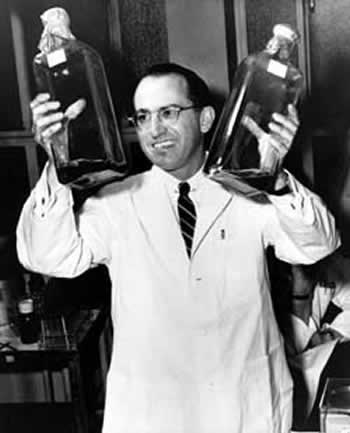Picture a lab scientist. White coat, pensive expression, microscope in hand. Glasses, perhaps. The person you have in mind (providing you are willing to humour a stereotype or two) may have a striking resemblance to Jonas Salk, the archetypal laboratory researcher, born in New York City on Wednesday 28th October 1914 — one hundred years ago today.
The name will be familiar to many. As creator of the inactivated polio vaccine (or IPV), Salk is cemented firmly into the annals of medical history. When his vaccine hit the shelves in 1955, the annual epidemics of poliomyelitis represented a fierce insult to postwar American civility: one particularly devastating bout in 1952 caused over 20,000 cases of paralysis and more than 3,000 deaths, mostly among children. The arrival of IPV was greeted with nationwide celebrations, and Salk was praised as a worker of miracles.

Jonas Salk at the University of Pittsburgh where he developed the first polio vaccine.
IPV has been in demand ever since, and its use in several countries has been sufficient to get rid of polio. Until recently, however, Salk’s injected vaccine has largely played second fiddle in eradication efforts. When the Global Polio Eradication Initiative was launched in 1988, it favoured an alternative formulation, Albert Sabin’s oral polio vaccine (OPV), as its weapon of choice.
But the spotlight may be shifting. With the eradication programme preparing for what is hoped to be a final onslaught, IPV is poised to take centre stage once more. Indeed, the World Health Organization recently recommended that all countries introduce at least one dose of Salk’s vaccine into routine immunisation by the end of 2015.
Why is IPV so important to polio eradication plans? What does the injected vaccine offer that the oral one does not? The centenary of Salk’s birth offers a fitting occasion to consider these issues.
A tale of two vaccines
Although renowned for its paralytic symptoms, polio infections actually start off in the gut. After the ingestion of infectious material (usually in the form of contaminated food or water), the virus replicates in the cells lining our intestines. In the majority of cases, it ends here, passing without symptoms or perhaps a few days of flu-like illness. But in every few hundred infections, the virus passes through the bloodstream and into the central nervous system. This is where it can do real damage: destroying nerve cells and causing muscle paralysis in the process.
In some cases, this paralysis is mild and temporary. In others, it is more severe, leaving victims permanently disabled. In an unlucky few, it is fatal.
The two formulations of polio vaccine take rather different approaches to preventing this. Salk tackled the problem by inactivating polioviruses with formaldehyde. When treated in this way, the viruses are no longer able to cause an infection, but crucially are still able to induce an immune response to polio when delivered by injection.
IPV is good at inducing protective antibodies against polio in the bloodstream. If a vaccinated individual later encounters a polio infection, the viruses will be neutralised by these antibodies before they have a chance to infect the central nervous system. No nerve damage. No paralysis.
But there are some important caveats. The vaccine is expensive, and its delivery by injection requires a skilled hand. What’s more, although vaccinated individuals are protected against polio’s symptoms, the virus is still able to replicate in the gut, enabling the chain of viral transmission to continue. This silent transmission is a concern when eradication is on the agenda: polio can lurk, undetected, passing from vaccinated individual to vaccinated individual without causing any symptomatic cases (a scenario that was recently seen in Israel).
To some extent, Sabin’s oral vaccine makes up for these shortcomings. OPV consists of live but substantially-weakened polioviruses. These viruses are able to mimic the infection caused by bona fide polio, but with a significantly-reduced risk of causing any neurological harm. Like IPV, the oral vaccine induces antibodies against polio in the blood, but unlike IPV, the live vaccine also produces a local immune response in the gut. Crucially, this local response will prevent future poliovirus encounters from establishing an infection. It can block the transmission chain.
The ability to induce immunity in the gut isn’t the only thing OPV has going for it. The vaccine is cheap and easy to administer, requiring just a few drops into the back of the mouth to take effect. When you are attempting to vaccinate every child under five across an entire country in a matter of days, as routinely carried out in regions still affected by polio, these are obvious bonuses.
The achievements made during the reign of OPV should not be underestimated. When the eradication initiative was launched, polio was a global disease responsible for roughly 1,000 cases of paralysis each day. Today, there are just three countries in which transmission of polio has never been halted – Nigeria, Pakistan, and Afghanistan – and the disease causes just a few hundred cases each year. Despite the huge challenges faced by the eradication initiative, from vaccine boycotts to a recent surge in violence targeting polio healthcare workers, we are 99% of the way towards one of the great achievements in medical history.

The first March of Dimes poster child.
It is in the final 1% of the eradication campaign that IPV becomes so important. For all of OPV’s qualities, it is still a live virus, and in occasional (very rare) circumstances, the weakened vaccine virus can regain its virulent qualities via mutation. Such cases of vaccine-associated paralysis are estimated to occur once in every 2.4 million doses of OPV. Every so often, these infections can even spread from person to person, resulting in circulating strains of vaccine-derived polio.
As we draw ever closer to eradication, these rare cases of vaccine-related disease become increasingly troublesome. As of 21st October, circulating vaccine viruses have added an extra 39 cases of polio to the 247 caused by wild viruses in 2014. Even though the risks of vaccination may be small, if you want to get rid of polio entirely, eventually you have to make the switch away from OPV.
The eradication endgame: counting down to zero
The current eradication plan looks something like this. By the end of 2015, every country will include at least one dose of IPV as part of each child’s routine schedule of jabs. In most of the world (especially in places where polio is still a problem), these injections will be supplemented by plenty of doses of oral vaccine – essential for inducing the transmission-blocking gut immunity required to halt the spread of polio.
If all goes to plan, this will bring an end to all cases caused by wild polioviruses. Good news, of course, but we’re not there yet. The rare cases of vaccine-related disease will still be an issue, especially the ones that can spread from person to person. So next we have to stop using OPV altogether.
When we are confident that enough children are receiving IPV, and that immunity levels are sufficient to prevent the spread of any lingering viruses, it will be necessary to stop using the very vaccine that has helped us get rid of 99% of the world’s polio. Oral vaccination will be brought to a halt, and IPV left to stand guard.
Both the oral and injected polio vaccines are indispensable to these eradication plans, so it is somewhat ironic that Salk and Sabin sustained such an infamous rivalry in the race to develop a polio vaccine – Sabin notoriously once suggested that Salk’s work could be achieved in a kitchen sink. The two vaccines may also make a better team than previously thought: in a pair of recent studies (one published in The Lancet and the other in the journal Science), researchers found that giving IPV to children who had previously received several doses of oral vaccine substantially boosted their transmission-blocking gut immunity. More than half a century after the first doses of IPV were given, we are still unearthing the vaccine’s hidden talents, and polio has never seemed more vulnerable.
Conclusion
One hundred years ago, a vaccine for polio did not exist, and little could be done to halt the annual epidemics of paralysis. It is hard, now, to fully appreciate the culture of fear that surrounded this disease. At the peak of each polio outbreak, entire hospital wards would be lined with iron lungs – coffin-like structures devoted to keeping their infected inhabitants breathing if paralysis spread to their lungs. Not every individual would leave their iron lung. Of those that did, many emerged with life-long disability.
Jonas Salk provided the first effective tool for preventing this dreaded disease, and polio has since been eradicated across much of the globe. The recent decision to include IPV in the routine immunisation of all infants is a fitting way to mark Salk’s centenary. It may well be a decision that helps consign polio to the history books.

Ed Parker is an epidemiologist in Imperial College London’s Vaccine Epidemiology Research Group. He is currently carrying out a PhD examining barriers to oral polio vaccine performance in low-income countries. When not at his desk, he can usually be found drinking overpriced coffee or playing Ultimate Frisbee.
